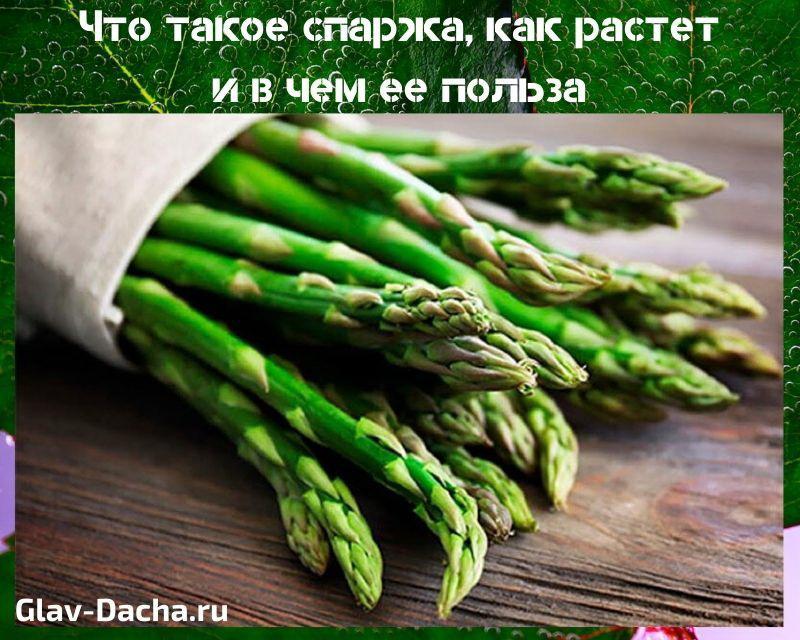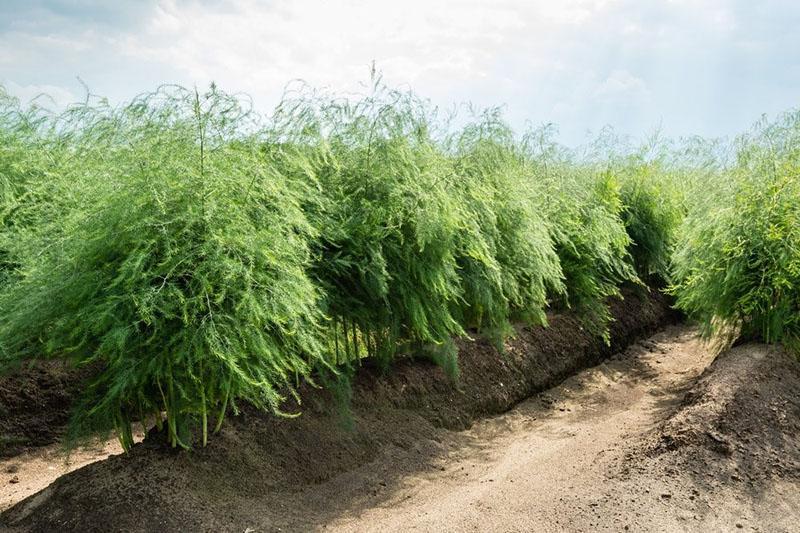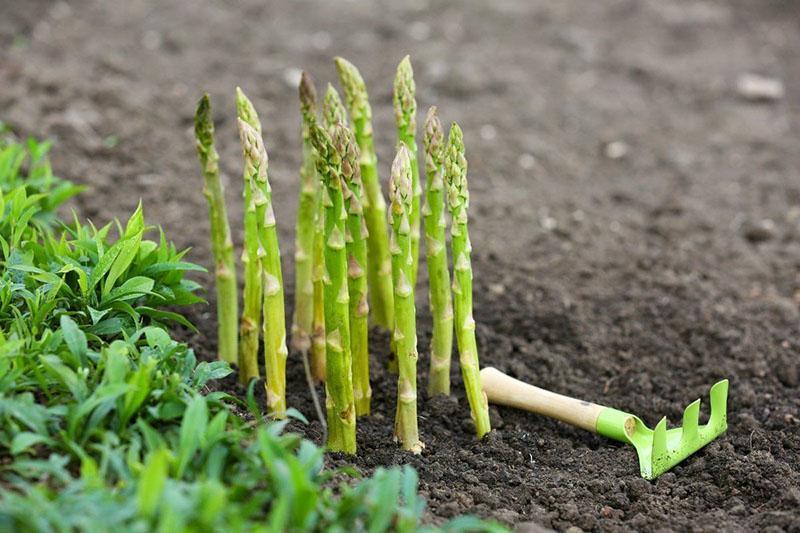What is asparagus, how it grows and what is its use
 Gift bouquets are often decorated with its graceful twigs, and delicacies are prepared from elastic shoots. What is asparagus that has attracted the attention of gardeners for centuries? Back in the days of the Roman Empire, the culture was grown in the fields as a useful food product. Included in various dishes that were prepared for the French kings. In Germany, the vegetable was served with truffles, red caviar and goat cheese. Modern Italians put asparagus in seafood pasta. It's no wonder why it is important to understand what asparagus is for a novice gardener.
Gift bouquets are often decorated with its graceful twigs, and delicacies are prepared from elastic shoots. What is asparagus that has attracted the attention of gardeners for centuries? Back in the days of the Roman Empire, the culture was grown in the fields as a useful food product. Included in various dishes that were prepared for the French kings. In Germany, the vegetable was served with truffles, red caviar and goat cheese. Modern Italians put asparagus in seafood pasta. It's no wonder why it is important to understand what asparagus is for a novice gardener.
Biological features of culture

At the base of the culture is a powerful rhizome, which is renewed every season. In its central area vegetative stems and buds are "stored". In early spring, delicate white-painted shoots grow from them. Over time, they turn green and acquire a solid structure. Small foliage and scarlet berries appear on them.
The scientific name for asparagus is asparagus. The plant is a dioecious crop, therefore it has heterosexual buds. The male flowers are yellow bells. Inside there is a pistil (underdeveloped) and stamens, which are arranged in several rows. Female buds are pale in color, rounded, with a row of stamens and a developed pistil. The bush feels great on one site for 20 years. Not afraid of harsh winters, withstanding temperatures down to 30 ° C.
The masculine asparagus produces more tough branches. The female culture is rich in thick shoots with the most delicate taste.
Description of popular species
 To understand what asparagus looks like, consider its varieties. The most famous are:
To understand what asparagus looks like, consider its varieties. The most famous are:
- Arzhentelskaya;
- Mary Washington;
- Gainlim;
- Snow head;
- Tsarskaya;
- Waldau;
- Cumulus F
Each species has its own advantages in terms of yield, taste, structure of shoots.
In addition, gardeners also note the following options for asparagus:
- white;
- green;
- lilac;
- sea.
 White asparagus is considered a special delicacy. Its value is not inferior to artichokes and exotic truffles. To obtain stems of this color, the plant is abundantly covered with soil. This prevents the production of chlorophyll in the sprouts. They taste very delicate. White asparagus has gained popularity in Germany, where it hits store shelves in early spring.
White asparagus is considered a special delicacy. Its value is not inferior to artichokes and exotic truffles. To obtain stems of this color, the plant is abundantly covered with soil. This prevents the production of chlorophyll in the sprouts. They taste very delicate. White asparagus has gained popularity in Germany, where it hits store shelves in early spring.
 Green asparagus was first discovered in the coastal regions of the Mediterranean. Today, its shoots are in great demand among consumers. In England, where a lot of asparagus grows, farmers set up special fields. In early spring, people come there to cut tender shoots on their own.
Green asparagus was first discovered in the coastal regions of the Mediterranean. Today, its shoots are in great demand among consumers. In England, where a lot of asparagus grows, farmers set up special fields. In early spring, people come there to cut tender shoots on their own.
In principle, green and white asparagus belong to the same crop variety. The main difference is the growing method.
 The purple look appeared thanks to a special technology. It was invented by French agronomists. Special conditions for development are created for the plant: complete darkness alternates with bright illumination. As a result, purple pigments are formed inside the shoots. These stems have a slightly bitter taste.However, during heat treatment, they turn green.
The purple look appeared thanks to a special technology. It was invented by French agronomists. Special conditions for development are created for the plant: complete darkness alternates with bright illumination. As a result, purple pigments are formed inside the shoots. These stems have a slightly bitter taste.However, during heat treatment, they turn green.
 Sea asparagus grows on the coast reservoirs and on salt marshes. In the photo you can see what this exotic culture looks like. It has a salty taste with hints of iodine, which is inherent in seafood.
Sea asparagus grows on the coast reservoirs and on salt marshes. In the photo you can see what this exotic culture looks like. It has a salty taste with hints of iodine, which is inherent in seafood.
Table of asparagus types for cultivation in Russia
| Popular
view | Ripening period | Region | Yield indicators (from one plant) | Features of culture |
| Argentel asparagus | early spring | with no restrictions | 250 g shoots | The aerial part of the stems is colored green with a purple tint. Underground shoots are white and slightly pinkish tops. |
| Mary Washington | end of March, beginning of April | southern | 200-250 g | Above ground stems are classic green. Underground specimens of cream color with a pale white flesh. |
| Tsarskaya | average ripening period | all areas of the country | up to 320 g | The variety is resistant to drought and frost. The edible part is green or white (underground). |
| Waldau | early ripe variety | no restrictions specified | maximum 350 g | The variety was created by Russian breeders in 2017. Ground shoots are green, underground ones are slightly yellowish. The internal structure of the stem is quite soft. |
| Cumulus F1 | first decade of March | any region of Russia | 300 g | Dutch hybrid designed for growing white asparagus. |
In Russia, cultivated asparagus began to be cultivated in the 18th century. Today the plant is found not only in middle latitudes, but also in Siberia, as well as in the Caucasus.
What is asparagus through the eyes of nutritionists
 The popularity of culture is due to the original internal composition.
The popularity of culture is due to the original internal composition.
Scientists note that the plant contains a number of components:
- proteins;
- carbohydrates;
- fats;
- vitamin A (retinol);
- B1 (thiamine);
- B2 (riboflavin);
- B4 (choline);
- B9 (folic acid);
- B11 (carnitine);
- C (ascorbic acid);
- vitamin E;
- PP (nicotinic acid)
- provitamin A (beta-carotene).

Since asparagus is an early ripening plant, it is rich in trace elements:
- iron;
- magnesium;
- phosphorus;
- calcium;
- potassium;
- selenium.
Each of them is an important building block for the body. Therefore, nutritionists are advised to include it in the diet. There are a huge number of dishes that are easy to prepare at home. Green asparagus shoots are used in all kinds of salads, side dishes and soups. They are baked with vegetables, mushrooms, meat. The product has excellent taste not only when cold, but also as a hot dish.
According to generally accepted etiquette, asparagus can be eaten by hand.
To properly prepare a culture, you need to know what it is - asparagus and "what it is eaten with." Experts suggest following simple rules:
- peel off the top of the white asparagus shoots;
- collect them in one bundle and tie;
- dipped in salted boiling water mixed with vegetable oil and lemon juice;
- boil for several minutes;
- the finished product is taken out of the water;
- leave to cool completely;
- used for cooking.
Green asparagus is simply washed before cooking, the coarse ends are cut off. It is boiled in the classical way, and then placed in ice water to preserve its rich green color. Add to vegetable salads or used as a side dish.
 Currently, soy asparagus, which has nothing to do with a traditional plant, has gained particular popularity. In fact, the product was invented by oriental culinary specialists and called it "fuju". It is made from soy milk. First, the liquid is boiled. When a greasy film forms on the surface, it is carefully removed and dried thoroughly. Over time, the product acquires a shriveled structure and is widely used in cooking. For its unusual appearance in Russia, it is called soy asparagus.
Currently, soy asparagus, which has nothing to do with a traditional plant, has gained particular popularity. In fact, the product was invented by oriental culinary specialists and called it "fuju". It is made from soy milk. First, the liquid is boiled. When a greasy film forms on the surface, it is carefully removed and dried thoroughly. Over time, the product acquires a shriveled structure and is widely used in cooking. For its unusual appearance in Russia, it is called soy asparagus.
Fuzhu contains an abundance of proteins. It is actively used by athletes and vegetarians to prepare nutritious meals.
Plant growing methods
 Having figured out a little what asparagus is, we will find out the secret of its cultivation. First of all, the plant needs to create suitable conditions for growth. It loves open and spacious areas where there is an abundance of sunlight. It is advisable to plant asparagus in a place protected from the wind. The soil should be fertile and free of weeds. Sandy soil is abundantly fertilized with humus.
Having figured out a little what asparagus is, we will find out the secret of its cultivation. First of all, the plant needs to create suitable conditions for growth. It loves open and spacious areas where there is an abundance of sunlight. It is advisable to plant asparagus in a place protected from the wind. The soil should be fertile and free of weeds. Sandy soil is abundantly fertilized with humus.
 But how does asparagus grow for food? Often it is planted in the garden in early spring using ready-made seedlings. Young sprouts are obtained in a traditional way, for example, in a greenhouse. Throw seeds into the soil. The sowing depth is about 3 cm.The interval between future bushes is 30 cm.The wells are fertilized compost or humus. When shoots appear, the soil is carefully weeded. Water if necessary.
But how does asparagus grow for food? Often it is planted in the garden in early spring using ready-made seedlings. Young sprouts are obtained in a traditional way, for example, in a greenhouse. Throw seeds into the soil. The sowing depth is about 3 cm.The interval between future bushes is 30 cm.The wells are fertilized compost or humus. When shoots appear, the soil is carefully weeded. Water if necessary.
For effective crop growth, it is advisable to place the seeds in a small container with moistened sand. Store in the cold from autumn to spring.
Asparagus is propagated by dividing the bushes throughout the season. The plant is not afraid of frequent transplants, especially when young. In the fall, the rhizome is dug up, cut into pieces (each must be with a bud) and placed in the ground. If necessary, carefully cover for the winter. In the spring, a depression of about 25 cm is made in the garden bed and rhizomes are planted. The bushes are placed at a distance of about 45 cm from each other. The soil is periodically weeded, watered and fertilized. Then they watch with joy how the asparagus grows in the backyard.
Harvesting and storage
 With proper care, asparagus bears fruit every year. In early spring, young stems are carefully cut as they emerge. After each procedure, the soil is carefully weeded and the bushes are heaped. At the end of the harvest, at least five strong shoots are left on the crop. New stems will grow from them, which contain an abundance of useful components.
With proper care, asparagus bears fruit every year. In early spring, young stems are carefully cut as they emerge. After each procedure, the soil is carefully weeded and the bushes are heaped. At the end of the harvest, at least five strong shoots are left on the crop. New stems will grow from them, which contain an abundance of useful components.
 Store asparagus in the refrigerator or freezer. All heads must be closed. It is better not to use sprouted specimens for food and storage. Choose green asparagus at least 8 cm in length. White shoots are very thick. Place the asparagus in a dry, spacious container or jar with a lid.
Store asparagus in the refrigerator or freezer. All heads must be closed. It is better not to use sprouted specimens for food and storage. Choose green asparagus at least 8 cm in length. White shoots are very thick. Place the asparagus in a dry, spacious container or jar with a lid.
The appearance of a light bloom or wrinkled surface indicates the maximum shelf life of the product.
The value of the product for health
 The sheer amount of minerals, vitamins and acids made the culture a popular ingredient and remedy. It is easy to digest and also has an exquisite taste. Consider how asparagus is useful for the body as a whole.
The sheer amount of minerals, vitamins and acids made the culture a popular ingredient and remedy. It is easy to digest and also has an exquisite taste. Consider how asparagus is useful for the body as a whole.
 Regular use of the product in the diet helps to maintain physical vitality. After all, the plant contains an abundance of carbohydrates. Thanks to potassium salts, kidney function is stimulated. Excess fluid is excreted from the body. The large amount of fiber found in the pulp of the shoots improves the digestion process.
Regular use of the product in the diet helps to maintain physical vitality. After all, the plant contains an abundance of carbohydrates. Thanks to potassium salts, kidney function is stimulated. Excess fluid is excreted from the body. The large amount of fiber found in the pulp of the shoots improves the digestion process.
 The presence of nicotinic acid helps fight hepatitis and atherosclerosis. Zinc accelerates the healing of open wounds. Calcium is used as a building material for bone tissue. Asparagus juice is dominated by a large amount of antioxidants, therefore it is effective in cosmetology. The product is mixed with honey, crushed cucumber or olive oil. The result is nourishing masks for the skin of the face, neck and head. Tincture of asparagus rhizome is taken for pain in the bladder, dropsy, arthritis and rheumatism. Fresh broth helps to treat diarrhea and dysentery. The main thing is to listen to the advice of a doctor and a nutritionist.
The presence of nicotinic acid helps fight hepatitis and atherosclerosis. Zinc accelerates the healing of open wounds. Calcium is used as a building material for bone tissue. Asparagus juice is dominated by a large amount of antioxidants, therefore it is effective in cosmetology. The product is mixed with honey, crushed cucumber or olive oil. The result is nourishing masks for the skin of the face, neck and head. Tincture of asparagus rhizome is taken for pain in the bladder, dropsy, arthritis and rheumatism. Fresh broth helps to treat diarrhea and dysentery. The main thing is to listen to the advice of a doctor and a nutritionist.
It is impossible to learn everything about asparagus in one go. However, even the first acquaintance with the culture is of interest. Biological features show appearance. The many varieties indicate the popularity of the culture. Nutritionists indicate the content of valuable components. The chefs offer delicious meals. Agronomists tell you how to grow asparagus on the site, harvest and store crops. And the value of a product puts it on the level of a medicine.How to grow and include green, white and purple asparagus wisely.